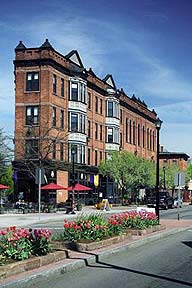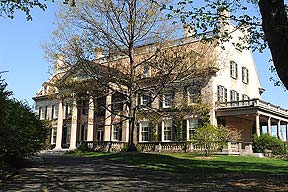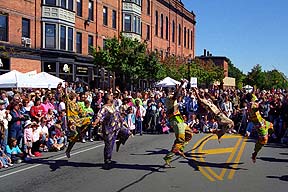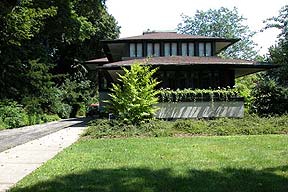 Southeast Quadrant - Neighborhood of The Arts
Southeast Quadrant - Neighborhood of The Arts
Perhaps more than any other Rochester neighborhood, The Neighborhood of the Arts (NOTA) projects a very notable metropolitan vibe. The dense diversity of art and culture includes a long list of attractions:
Within its 15 city blocks long and three blocks wide boundaries, NOTA’s turn-of-the century single-family homes are neighbors to restaurants, cafes and coffee shops, bakeries, gift shops and a wide array of art studios and galleries. NOTA neighborhood boundaries reach north to the CSX Railroad lines, south to East Avenue, west to the Inner Loop and east to Culver Road (East Avenue to Atlantic Avenue).
Like many urban neighborhoods between 1950 and 1990, NOTA’s community diminished as residents and businesses flocked from cities to suburbs. The rejuvenation began in the early 1980s, when neighborhood activists began buying up properties and rehabbing them. In 1981, the 19th century Towner “flatiron” building at the corner of Atlantic and University Avenue was saved from demolition. This transformation of the badly-blighted NOTA landmark catalyzed its rebound.
 In the mid 1990s, an engaged community of residents, creatives and businesspeople focused on art and culture, community, diversity and walkability, led the neighborhood’s revitalization and transformation.
In the mid 1990s, an engaged community of residents, creatives and businesspeople focused on art and culture, community, diversity and walkability, led the neighborhood’s revitalization and transformation.
Through the cooperation of City, state and federal agencies, the outdoor ArtWalk was created in 2002. This award-winning re-design of the neighborhood's main thoroughfare – featured narrowing the roadway, widening of the sidewalks and infusing the neighborhood with homegrown public art. ARTWalk transformed the neighborhood into a magnet for residents, businesses and visitors. In July 2010, additional funding from the National Endowment of the Arts award was used to extend and expand ARTWalk including adding the centerpiece 0 the Memorial Art Gallery’s Centennial Sculpture Park at the corner of University and North Goodman.
NOTA area architecture also draws visitors to its streets. On East Boulevard, a prairie-style house by world-renown architect Frank Lloyd Wright, the E.E. Boynton House, still charms passersby.
 The most famous element of NOTA is the George Eastman House International Originally the home of the Eastman Kodak , the 1905 Colonial Revival mansion and its gardens welcome visitors from all over the world. George Eastman Museum, which opened in 1949, is one of the premier photography and film museums and archives in the world. It also includes the 535-seat historic Dryden Theater and world-leading training program for film and photograph conservation.
The most famous element of NOTA is the George Eastman House International Originally the home of the Eastman Kodak , the 1905 Colonial Revival mansion and its gardens welcome visitors from all over the world. George Eastman Museum, which opened in 1949, is one of the premier photography and film museums and archives in the world. It also includes the 535-seat historic Dryden Theater and world-leading training program for film and photograph conservation.
Just a short walk away from the Eastman Museum, Village Gate Square on North Goodman Street. Once including a Chiclets gum factory in the early 20th century, it went from eyesore to booming urban success story through the efforts of the late Gary Stern, a Rochester developer, who saw its potential and began its restoration in the late 1970s and was continuing its expansion right up to his passing in 2016.
Today Village Gate complex is an eclectic mixed-use development with loft apartments, cafes and restaurants, retail shops, offices, whimsical art, a cozy courtyard and much more. Among them are Wosa’s Braids and Nails and Get Caked bakery.
Writers and Books on University Avenue is marked by a giant-sized pencil sculpture along ArtWork, in front, offers classes and workshops for writers and film, drama and literature lovers of all ages in an old restored Police Precinct building.
 The list of cultural landmarks continues to grow with the arrival of the very eclectic Multi-Use Cultural and Community Center, housed in a renovated 1888 wooden mission-style church on Atlantic Avenue.
The list of cultural landmarks continues to grow with the arrival of the very eclectic Multi-Use Cultural and Community Center, housed in a renovated 1888 wooden mission-style church on Atlantic Avenue.
NOTA is also still a hub of industry and manufacturing.
The monumental and historic Gleason Works, the world’s largest gear-making manufacturer building, stretches nearly a quarter of a mile along University Avenue. It is also noteworthy in is hiring of a woman pioneer in the field of engineering. Founder William Gleason, an Irish immigrant, started the company in the mid1880s. When his eldest son died, he invited Catherine Anselm “Kate” Gleason to join him. She went on to study engineering at Cornell and Mechanics Institute (now RIT), founded her own company, the Ingle Machining Company in 1913, and in 1914, became the first woman to be elected to full membership in the American Society of Mechanical Engineers.
Along with its every day attractions, events bring thousands more to the NOTA. Anderson Alley Artists on North Goodman Avenue open their studios to the public on the second Saturday of each month. In September, the Memorial Art Gallery’s Clothesline Festival attracts hundreds of artists and tens of thousands of art lovers.
Exciting urban planning and community commitment continues today in NOTA, Increasing its walkability even more, the western edge of the neighborhood is being transformed back into a pedestrian-friendly traditional urban boulevard through the transformation of 1950s-1960s-era Inner Loop fill, bringing it back to street level and the redevelopment of Union Street.
Additional Information
If you would like additional information on this neighborhood, please contact the Southeast Quadrant Neighborhood Service Center:
320 N Goodman St - Suite 209
Rochester, New York 14607
(585) 428-7640
Email: Erica.Hernandez@cityofrochester.gov